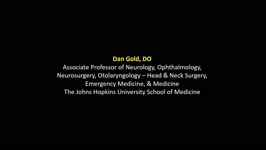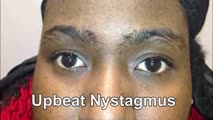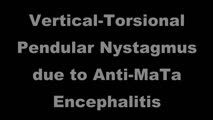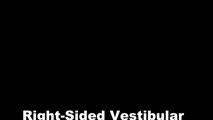A collection of videos relating to the diagnosis and treatment of eye movement disorders. This collection includes many demonstrations of examination techniques.
Dan Gold, D.O., Associate Professor of Neurology, Ophthalmology, Neurosurgery, Otolaryngology - Head & Neck Surgery, Emergency Medicine, and Medicine, The Johns Hopkins School of Medicine.
A collection of videos relating to the diagnosis and treatment of eye movement disorders.
NOVEL: https://novel.utah.edu/
TO
| Title | Description | Type | ||
|---|---|---|---|---|
| 326 |
 |
Upbeat and Downbeat Nystagmus Due to Anti-VGCC Antibodies | Seen here are two patients who presented with imbalance and vertical oscillopsia, the first with upbeat nystagmus, and the second with downbeat nystagmus. Both patients were found to have voltage-gated calcium channel antibodies in serum without evidence of systemic malignancy. The UBN patient had m... | Image/MovingImage |
| 327 |
 |
Upbeat Nystagmus & Ocular Flutter Due to Cerebellar Pilocytic Astrocytoma | This is a 20-year-old woman who was diagnosed with a cerebellar pilocytic astrocytoma at age 10 after presenting with severe headaches and hydrocephalus. She underwent incomplete resection and radiation therapy at that time. She experienced mild vertical oscillopsia in upgaze at baseline, and increa... | Image/MovingImage |
| 328 |
 |
Upbeat Transitioning to Downbeat Nystagmus in Wernicke's Encephalopathy | This is a 30-year-old man with a history of alcohol abuse who presented to the hospital with inability to walk after several weeks of heavy drinking and malnutrition. While in the hospital, he noted that when he would look straight ahead, everything he saw would appear to be bouncing up and down - a... | Image/MovingImage |
| 329 |
 |
Upbeating and Gaze-evoked Nystagmus, V-pattern Esotropia from Bilateral 4th Nerve Palsies | Video example of a patient with upbeating and gaze-evoked nystagmus, V-pattern esotropia from bilateral 4th nerve palsies. | Image/MovingImage |
| 330 |
 |
Using Video Head Impulse Testing to Unmask Covert Saccades in Compensated Vestibular Neuritis (Figures 1 and 2) | This is a 30-year-old woman who experienced the acute vestibular syndrome (prolonged vertigo for >24 hours, nausea, unsteadiness, spontaneous nystagmus, head motion intolerance) and was diagnosed with vestibular neuritis. This diagnosis was based on a positive head impulse test to the left (see Figu... | Image |
| 331 |
 |
Using Video Head Impulse Testing to Unmask Covert Saccades in Compensated Vestibular Veuritis | This is a 30-year-old woman who experienced the acute vestibular syndrome (prolonged vertigo for >24 hours, nausea, unsteadiness, spontaneous nystagmus, head motion intolerance) and was diagnosed with vestibular neuritis. This diagnosis was based on a positive head impulse test to the left (see Figu... | Image/MovingImage |
| 332 |
 |
The Utriculo-Ocular Motor Pathways - Physiologic and Pathologic Ocular Tilt Reaction: OTR Diagram Pathologic EOMs Labelled (Figure 3) | A skew deviation is a non-paralytic vertical ocular misalignment that is due to imbalance in the utriculo-ocular motor pathways. While vestibular jerk nystagmus is a consequence of static semicircular canal pathway imbalance (e.g., left-beating nystagmus due to acute right vestibular hypofunction fr... | Image |
| 333 |
 |
The Utriculo-Ocular Motor Pathways - Physiologic and Pathologic Ocular Tilt Reaction: Pathologic OTR (Figure 2) | A skew deviation is a non-paralytic vertical ocular misalignment that is due to imbalance in the utriculo-ocular motor pathways. While vestibular jerk nystagmus is a consequence of static semicircular canal pathway imbalance (e.g., left-beating nystagmus due to acute right vestibular hypofunction fr... | Image |
| 334 |
 |
The Utriculo-Ocular Motor Pathways - Physiologic and Pathologic Ocular Tilt Reaction: Physiologic Ocular Tilt Reaction (OTR) (Figure 1) | A skew deviation is a non-paralytic vertical ocular misalignment that is due to imbalance in the utriculo-ocular motor pathways. While vestibular jerk nystagmus is a consequence of static semicircular canal pathway imbalance (e.g., left-beating nystagmus due to acute right vestibular hypofunction fr... | Image |
| 335 |
 |
Valsalva (Closed Glottis) | Valsalva (closed glottis or pinched nose): instruct the patient to take a deep breath and ‘bear down' (closed glottis) or take a deep breath and ‘try to pop their ears' (pinched nose). Assess for nystagmus. In superior canal dehiscence, pressure changes may be transmitted to the superior canal, ... | Image/MovingImage |
| 336 |
 |
Vertical Semicircular Canal Pathways | Anterior Canal Pathway Afferents that originate in the anterior canals (AC) of the peripheral labyrinth first synapse in the ipsilateral vestibular nucleus. Three pathways exist: 1) medial longitudinal fasciculus (MLF) - right AC afferents to right medial vestibular nucleus (MVN), decussate and asc... | Image |
| 337 |
 |
Vertical Vergence and Fusional Amplitude | Essential information on vertical fusional vergences. | Text |
| 338 |
 |
Vertical-Torsional Pendular Nystagmus and Convergence Spasm Due to Anti-MaTa Encephalitis | This is a 50-yo-woman with debilitating oscillopsia due to a high frequency (6 Hz) vertical-torsional pendular (quantitative eye movement recordings were performed) nystagmus. She also had intermittent double vision due to (organic) convergence spasm. Her nystagmus and spasm were thought to be relat... | Image/MovingImage |
| 339 |
 |
Vestibular Evoked Myogenic Potentials (VEMPs) | 𝗢𝗿𝗶𝗴𝗶𝗻𝗮𝗹 𝗗𝗲𝘀𝗰𝗿𝗶𝗽𝘁𝗶𝗼𝗻: Vestibular-evoked myogenic potentials (VEMP) are electromyographic potential reflex tests that reflect the function of the saccule in cervical VEMP and the utricle in ocular VEMP.1 In the cervical VEMP an inhibitory refle... | Text |
| 340 |
 |
Vestibular Neuritis with + Head Impulse Test and Unidirectional Nystagmus | Vestibular neuritis is the most common cause of the acute vestibular syndrome, which is characterized by continuous vertigo and spontaneous nystagmus lasting days. It may be mimicked by central causes, including stroke, but in the hands of subspecialists, the HINTS+ (Head Impulse, Nystagmus, Test o... | Image/MovingImage |
| 341 |
 |
Vestibular Neuritis with + Head Impulse Test and Unidirectional Nystagmus (Figure 1) | Vestibular neuritis is the most common cause of the acute vestibular syndrome, which is characterized by continuous vertigo and spontaneous nystagmus lasting days. It may be mimicked by central causes, including stroke, but in the hands of subspecialists, the HINTS+ (Head Impulse, Nystagmus, Test of... | Image |
| 342 |
 |
Vestibular Neuritis with a Peripheral Skew Deviation | 𝗢𝗿𝗶𝗴𝗶𝗻𝗮𝗹 𝗗𝗲𝘀𝗰𝗿𝗶𝗽𝘁𝗶𝗼𝗻: This is a 55-year-old hypertensive man who developed acute onset continuous vertigo and presented to the Emergency Department (ED) after several hours of symptoms. He was noted to have spontaneous nystagmus and had a nor... | Image/MovingImage |
| 343 |
 |
Vestibulocerebellum Lecture | A lecture on vestibulocerebellum. | Image/MovingImage |
| 344 |
 |
Vibration | Vibration: instruct the patient to self-administer this test with an electric toothbrush or vibrator/massager, if available. Vibration of the mastoids and vertex will induce an ipsilesional slow phase with unilateral vestibular loss (https://collections.lib.utah.edu/details?id=1427582). | Image/MovingImage |
| 345 |
 |
Vibration and Hyperventilation-induced Nystagmus from Vestibular Schwannoma | 𝗢𝗿𝗶𝗴𝗶𝗻𝗮𝗹 𝗗𝗲𝘀𝗰𝗿𝗶𝗽𝘁𝗶𝗼𝗻: This is a 50-yo-woman with imbalance, and with fixation removed on her examination (with Frenzel goggles), there was no spontaneous nystagmus. Using a handheld vibrator to vibrate the mastoids and vertex, there was a righ... | Image/MovingImage |
| 346 |
 |
Vibration-Induced Nystagmus in a Patient with Vestibular Neuritis | 𝗢𝗿𝗶𝗴𝗶𝗻𝗮𝗹 𝗗𝗲𝘀𝗰𝗿𝗶𝗽𝘁𝗶𝗼𝗻: This is a 60-year-old man who experienced the sudden onset of vertigo, oscillopsia, imbalance, nausea and vomiting. He was seen in the emergency department within hours and had spontaneous right-beating (RBN) and torsiona... | Image/MovingImage |
| 347 |
 |
Video Head Impulse Testing | 𝗢𝗿𝗶𝗴𝗶𝗻𝗮𝗹 𝗗𝗲𝘀𝗰𝗿𝗶𝗽𝘁𝗶𝗼𝗻: The video head impulse test (vHIT) is a clinical assessment technique used to assess the function of the semicircular canals-the angular acceleration detectors-which initiate the vestibulo-ocular reflex (VOR). The HIT and... | Text |
| 348 |
 |
The Virtual (Telemedicine) Ocular Motor Examination | 𝗢𝗿𝗶𝗴𝗶𝗻𝗮𝗹 𝗗𝗲𝘀𝗰𝗿𝗶𝗽𝘁𝗶𝗼𝗻: This document is based on Approach to the Ocular Motor & Vestibular History and Examination: https://collections.lib.utah.edu/ark:/87278/s64x9bq1, but adapted and edited for the telemedicine exam. Virtual Ocular Motor Ex... | Image/MovingImage |
| 349 |
 |
The Virtual (Telemedicine) Vestibular Examination | 𝗢𝗿𝗶𝗴𝗶𝗻𝗮𝗹 𝗗𝗲𝘀𝗰𝗿𝗶𝗽𝘁𝗶𝗼𝗻: This document is based on Approach to the Ocular Motor & Vestibular History and Examination: https://collections.lib.utah.edu/ark:/87278/s64x9bq1, but adapted and edited for the telemedicine exam. Virtual vestibular ex... | Image/MovingImage |
| 350 |
 |
Visual Sensitivity | Image/MovingImage |
